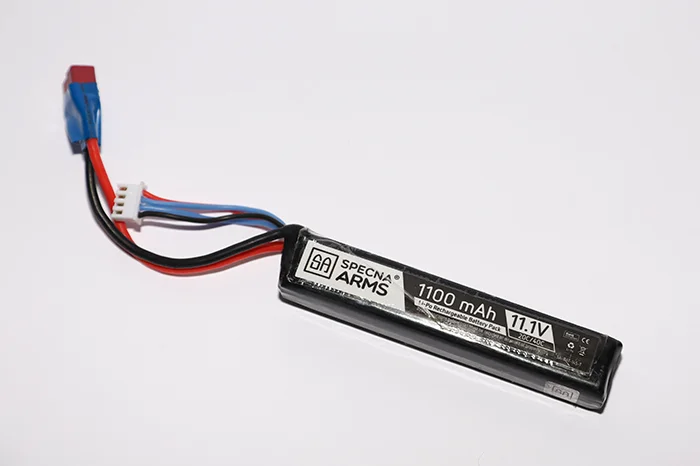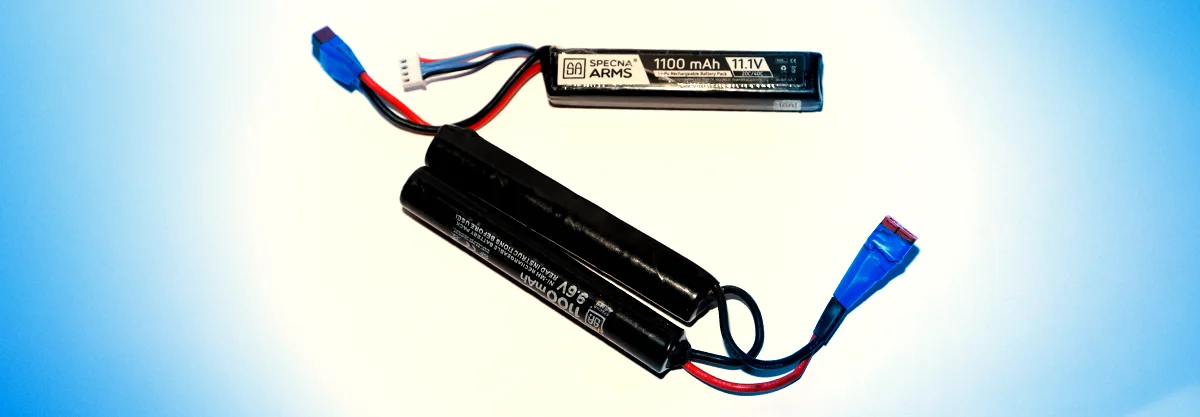Comparison of Li-Po and Li-Ion batteries
What batteries do we use for airsoft guns?
Some players probably still remember the times when the best way to get a sensible replica power pack was to build it yourself. Alternatively, some ordered them from modelling stores, which often also produced them themselves. To simplify, such a construction consisted in obtaining nickel-hydrogen cells and combining them into a package with the parameters required by us. Over time, these types of batteries have been replaced by ready-made solutions offered by well-known airsoft brands, and currently the most common are lithium-based batteries.

Why exactly lithium? I am not a chemist so my explanation will be rather simple. The point is, this metal has one extra electron. Its feature is that we can easily control the process in which the lithium element gets rid of it, but also gains it again. This is associated with energy transfers, which in turn can be used in the operation of the batteries. Packages based on this material are now dominant in many areas. They are widely used in electronics, where they power cell phones, laptops or other portable devices, but we can also find them in the floors of electric cars as their energy sources. The main miners of lithium are Chile, China, Argentina and Australia, and global demand continues to grow. This will certainly lead to further breakthroughs in the technology of energy cell production.
Lithium-based batteries and their features
But let's go back to our airsoft backyard. The main types of lithium-based batteries that we find in our hobby are lithium-polymer and lithium-ion cells. They differ in structure in that they have a different type of filling between the lithium plates responsible for the aforementioned electron transfer. As a result, there are slight differences in their operation and properties. The most popular Li-Po and Li-Ion batteries usually have a nominal voltage of 3.7 V per cell. And so, if we have two of them, the battery has a voltage of 7.4 V, and when there are three of them - 11.1 V. Packets using a polymer are easy to recognize by the fact that they are angular. Due to the production process, they are usually a single cuboid, then we will commonly call them stick or brick, or a combination of two or three such shapes. The most popular type of lithium-ion cell is the widely used 18650 batteries. An interesting fact is that this type of cell was used to power the original Tesla Roadster from 2007.

Li-Ion cells are often used to power up portable electronics like shown in this picture.
But what is the practical difference between these types of batteries? Li-Ion has a better energy density. Hence, packages of comparable size can power our replicas for a much longer time. In practice, this means that even many hours of milsim or other long-lasting games can be easily handled on the large 11.1V package. In the Internet, I even found reports that this type of Titan packets can be used for up to 5 days. Despite their obvious advantage over other technologies, I would be far from such bold statements. Of course, it is difficult to talk about specific performance here, because they will depend on many factors, such as the power of the airsoft gun, its rate of fire or even how well it was put together. In the case of Li-Po batteries, however, it should be expected that we will have to replace them after a few hours of play.
Another characteristic of the discussed power sources that is worth mentioning is the current efficiency. It is a parameter "C" describing the batteries. If you are interested in a more detailed explanation of this term, check out one of the previous articles on the Gunfire blog about batteries where I explain it. Batteries made with lithium-polymer technology will usually have better current efficiency. This is because Li-Ion cells were designed rather for long-term, but even powering of devices. No sudden spikes in energy demand. It will be great for working in a laptop, but not necessarily in an airsoft replica. Therefore, it can often be the case that after switching to Li-Ion batteries, we notice a slightly worse trigger response in our aisoft gun.
Li-Po and Li-Ion batteries - is it worth paying extra?
By analysing the differences between Li-Po and Li-Ion batteries, one can come to a fairly simple conclusion. Both types of packages are based on lithium, but those that use polymers in their structure are characterized by a lower price and worse capacity than their lithium counterparts. So, you can ask a fairly pertinent question. Is it worth paying extra? How often is it, and here the answer is ambiguous. Currently, the airsoft market does not have many manufacturers of Li-Ion packages, hence it is difficult to talk about extensive competition. In the case of Li-Po cells, it is definitely different and many brands compete for our attention. This increases our choice. Personally, I don't use lithium-ion batteries. I believe that they only have a niche application for people who need the largest capacity they can get in a given volume. They are definitely an interesting proposition for milsim players who may have difficult access to chargers during long games. Most regular airsofters, however, can easily handle the more basic Li-Po cells.
If we want the best response to the trigger, it is much easier to find a Li-Po battery with high current efficiency. In addition, they will also offer more choice in terms of size and form. Individual packets may have different sizes and formats, so we can successfully match them to different replicas. In summary, lithium polymer cells are a more universal choice for most airsoft players. In turn, lithium-ion batteries will be best for people whose highest priority is the capacity of the package.
Author: Boreq
Check out similar entries:






